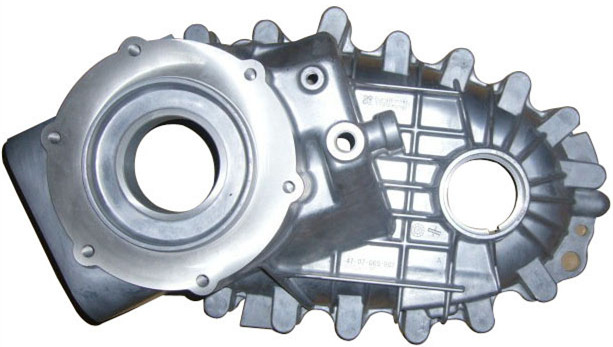1. There are stripes and metal flow marks on surface of die castings.
Reasons: (a) too shallow flow channel of pouring gate; (b) too high injection pressure, causing too high flow rate of metals and splash of molten metal.
Solutions: (a) deepening flow channel of pouring gate; (b) reducing injection pressure.
2. There are tiny raised marks on surface of die castings.
Reasons: (a) rough surface; (b) scratches, pits and cracks inside cavity surface.
Solutions: (a) polishing cavity; (b) replacing cavity or reprocessing surface.
3. Surface of die castings is unclean or rough or has pressing marks of push rod.
Reasons: (a) too long push rod; (b) rough cavity surface and remaining sundries.
Solutions: (a) adjusting the length of push rod; (b) polishing cavity and cleaning sundries or oil stains.
4. Surface of die castings partially deforms or has cracks.
Reasons: (a) unevenly distributed or insufficient push rods, or uneven force applied on push rods; (b) slightly tilted fixed plates of push rods during operation, causing small force on one side but large force on the other side and hence deformation and cracks of die castings; (c) too thin surface walls of die castings, causing deformation after shrinkage.
Solutions: (a) increasing the number of push rods and adjusting their distributed position so as to make force applied on push rods uniform; (b) adjusting or reinstalling fixed plates of push rods.
5. There are gas holes on surface of die castings.
Reasons: (a) too much amount of lubricant agent; (b) blocked exhaust holes.
Solutions: (a) using appropriate amount of lubricant agent; (b) increasing the number of exhaust holes or repairing the holes so as to make exhaust gas unblocked.
6. There are shrinkage holes on surface of die castings.
Reasons: (a) improper process of die castings and greatly varied wall thickness; (b) too high temperature of molten metal.
Solutions: (a) increasing processing holes in the areas where surface walls are thick so as to make wall thickness uniform; (b) decreasing temperature of molten metal.
7. Die castings are difficult to form shape and have unclear outer contour.
Reasons: (a) insufficient pressure from die-casting machines or too low injection pressure; (b) too thick feed inlets; (c) improper position of pouring gates, directly striking metal surface.
Solutions: (a) replacing die-casting machines with those having relatively high injection pressure; (b) decreasing flow channel thickness of feed inlets; (c) changing position of pouring gates to avoid direct impact on die castings.
8. Part of die castings is unshaped and cavity cannot be filled up.
Reasons: (a) too low temperature of die-casting moulds; (b) low temperature of molten metal; (c) too small pressure from die casting machines; (d) insufficient molten metal and too fast injection speed; (e) failure to exhaust gas.
Solutions: (a) increasing temperature of die-casting moulds and molten metal; (b) replacing die casting machines with those having great pressure; (c) adding enough molten metal, decreasing injection speed and increasing thickness of feed inlets.
9. Angled sections of die castings cannot be filled up.
Reasons: too large internal pouring gate; (b) too small pressure from die casting machines; (c) failure to exhaust gas due to poor ventilation in angled sections.
Solutions: (a) reducing internal pouring gate; (b) replacing die casting machines with those having great pressure; (c) improving exhaust system.
10. Die castings have incompact structure and low strength.
Reasons: (a) insufficient pressure from die casting machines; (b) too small internal pouring gate; (c) blocked exhaust holes.
Solutions: (a) replacing die casting machines; (b) enlarging pouring gate; (c) checking exhaust holes and ensure ventilation.
11. There are gas holes in die castings.
Reasons: (a) incorrect flow direction of molten metal and direct impact on cavity of die castings, causing vortex which surrounds air and then producing gas holes; (b) too small internal pouring gate and too high flow speed of molten metal, making gas holes blocked before gas exhausts from the holes and then keeping gas in die castings; (c) too deep cavity of moving die, causing difficulty of ventilation and gas exhaust.
Solutions: (a) designing distributary gas channels and forms to avoid direct impact of molten metal on cavity; (b) properly enlarging internal pouring gate; (c) improving design of models; (d) properly designing and increasing gas holes.
12. There are sundries in die castings.
Reasons: (a) unclean molten metal containing sundries; (b) impure alloy composition; (c) unclean cavity of moulds.
Solutions: (a) cleaning sundries by pouring method; (b) replacing alloy; (c) cleaning cavity of molds to make it clean.
13. Molten metal splashes during process of die castings.
Reasons: (a) incompactness and relatively large clearance between moving die and fixed die; (b) insufficient clamping force; (c) malalignment of moving die and fixed die of die casting machines.
Solutions: (a) reinstalling moving die and fixed die; (b) enlarging clamping force; (c) adjusting die casting machines to make moving die and fixed die parallel.

